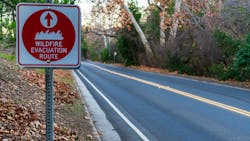California Board To Host Virtual Meeting April 14 On 2021 Wildfire Mitigation Plan Updates
The California Public Utilities Commission on April 2 said that the Wildfire Safety Advisory Board (WSAB) will host a virtual meeting on April 14, and is accepting comments, on its draft recommendations on the 2021 Wildfire Mitigation Plan (WMP) Updates for Large Investor-Owned Utilities (IOUs).
As the commission noted, Assembly Bill 1054, signed into law in July 2019, created the WSAB, which consists of independent expert advisors, to advise the Wildfire Safety Division (WSD) within the commission on wildfire safety measures, including plans written by utilities, so that the commission can more effectively regulate the safety of IOUs.
According to the April 1 draft recommendations, following the catastrophic fires of 2017 and 2018, the commission opened a rulemaking proceeding to provide guidance on the form, contents, and process for review and implementation of the IOUs’ Wildfire Mitigation Plans (WMPs) to be filed under Senate Bill 901. Assembly Bill (AB) 1054 and AB 111 established the WSAB, the document noted.
In its document, the WSAB said that California’s increase in wildfire events is partly attributable to several factors that become problematical when they occur synchronously, such as an extended period of drought, upwards of 10 years; increased fuel for fires in certain forest types; unprecedented climatological conditions that cause extreme weather events; and housing expansion, which increases the possibility of human-caused ignitions coinciding with extreme fire-weather. Utility related wildfires have been responsible for a disproportionate share of wildfire-related consequences, the WSAB said.
Discussing risk assessment, mapping and resource allocation, the WSAB said that the three IOUs appear to deploy and support improved forms of investment prioritization compared to their 2020 WMP filings. For instance, San Diego Gas & Electric (SDG&E) is actively refining its process around resource allocation methodology to support the creation of long-term and immediate plans for capital investment, operation, and maintenance, as well as appropriate asset retirement, the WSAB said.
Among its recommendations, the WSAB said that the WSD should request that the IOUs explain how they evaluate errors, such as line strikes, that occur during vegetation removal or repair and maintenance, and how those errors are factored into their risk assessment. In addition, the WSAB said that the WSD should consider whether the WMPs provide enough information about modeling outcomes and how those outcomes have impacted utility decision making. For instance, the WSAB said, the WSD may need the IOUs to provide maps that visualize modeling outcomes and additional descriptions about how those outcomes resulted in specific mitigation decisions.
On vegetation management, the WSAB said that it is concerned about comments from the public about tree removals after wildfires, adding that vegetation removal occurring during an evacuation should not be permitted, and that residents must be informed of all planned activities.
The WSD should, for instance, review any notices of violation issued by other state agencies as they relate to utility vegetation management, as well as request that the IOUs’ WMPs report any notices of violation issued by other state agencies as they relate to utility vegetation management and environmental stewardship.
The WSAB also recommended that the WSD explore the possibility of directing the IOUs to create a statewide database of tree species, traits, growth rates, morphological characteristics, and locations along environmental gradients.
Discussing grid hardening, operations, inspections, and emerging technology matters, the WSAB said that all three IOUs appear to have made progress in meeting their 2020 WMPs’ grid hardening goals and objectives, and most plan on continuing that progress this year. For instance, Southern California Edison (SCE) in 2020 installed more than 960 circuit miles of covered conductor and plans to install 1,000 circuit miles this year, as well as 1,600 circuit miles in 2022.
Among its recommendations, the WSAB said that the WSD should request that the IOUs evaluate the risk involved in keeping idle lines or equipment energized versus disconnecting completely when not in use.
In addition, the WSAB recommended that the WSD request that the IOUs provide more detail about how they will ensure the workforce will become qualified, their training plans, including length of training.
Information about how to access the virtual meeting can be found in the commission’s statement.
